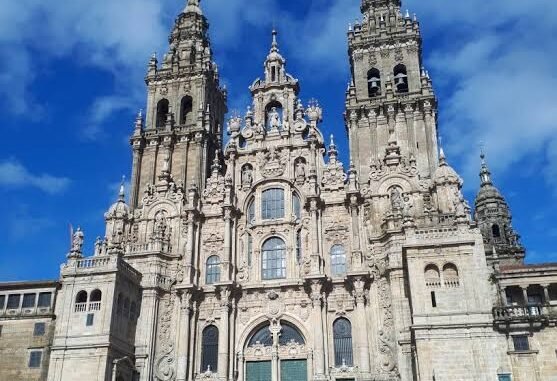
We were stunned by the strong gusts, which slapped our faces with rain ponchos. Following the Portuguese Coastal Camino through Spain, three Indian women had set out on the El Camino de Santiago, traveling from Baiona to Santiago de Compostela. As the storm threatened this prized bucket list path, we three in our 50s moaned in dismay as the sea churned like a turbulent cauldron and the rain hurt our faces. Disempowered by the reality that no equipment can keep the rain in Spain at bay, we pushed on with squeaky shoes, chattering teeth, and whispered prayers. It is evident that it is not limited to the plain.
All routes lead to the city constructed for Saint James’ remains, which is the destination of the centuries-old pilgrimage known as the El Camino. It’s transforming or spiritual for many. For us, it was the ease of leisurely travel and spiritual reflection—no airlines to catch, no busses to miss. Six towns in seven days, one foot after the other, throughout breathtaking Galicia. Because of the favorable weather in April, we had cautiously decided to take the Portuguese Coastal Route. We began in Baiona and traveled to the majestic Santiago de Compostela Cathedral via Vigo, Redondela, Pontevedra, Caldas de Reis, and Padrón. We were spiritually, physically, and emotionally healed by the trail.
Planning And Preparation
Ashita Sawhney, a design professor from the US; Deepika Quintas, a Swedish potter; and I, planned this journey a year in advance. We trained daily with knapsacks, gathered what we thought was rainproof gear (it wasn’t), and booked our luggage transfers with Natural Adventures, which also arranged bed and breakfast.
Deepika and I began as tourists in Lisbon, meandered through Fátima, Porto, and Braga, and reached Baiona with a few fellow pilgrims—delivered via a cabbie whose Fernando Alonso-style driving forced a cruel choice: EUR 30 for slow, EUR 50 for fast. We foolishly chose fast. Never again.
First Steps In Baiona
A view of Port Baiona near Mountain GaliciaShutterstock Ashita joined us in Baiona, a serene fishing village kissed by yachts and watched over by Monterreal Castle. We stood at the Paseo Alfonso IX, marvelling at the replica of La Pinta, Columbus’s ship. Over a Galician dinner of scallops and fresh fish at Casa Rita, we toasted our adventure with Spanish coffee. Our hotel, Bahia Bayona, opened onto a breathtaking bay. By morning, we were sleepless but eager. Bags were packed and left for the Correo (luggage transfer), breakfast inhaled, and off we went — thunder, lightning, and rain becoming our early companions. Twenty-three kilometres later, we squelched into Hotel Silken Vigo, soaked but strangely exhilarated. Walking With The Past And Present We marvelled at pilgrims of the old days who walked for months—with no gear, gadgets, or signs. Today, at least, we had our Camino passports swinging around our necks and the scallop shell, the ancient symbol of St James, pinned to our bags and the yellow arrow. Each pilgrim walks – for spirituality, fitness, grief, or the thrill of testing one’s meagre physical limits. We passed people clutching rosaries, chanting novenas, walking dogs, carrying babies each with a life story. The Camino began to clear many cobwebs. Eckhart Tolle’s voice echoed: “Surrender becomes easier when you realise the fleeting nature of all experiences.”
Baiona Storms
A panorama across Marina Vigo, SpainShutterstock The sea had turned an angry grey. Restaurants were shuttered; we found just one café, where we warmed our icy hands on steamy coffee cups, devoured cold tapas. By afternoon, the sun broke through—our mood, like our backpacks, lightened. We doodled our way down the trail—sometimes like headless chickens. Google Maps failed us (as did the yellow arrows). Camino rules: dirt paths over asphalt. In Vigo, arrows were nearly invisible. We followed cryptic maps, prayed, resolved, and finally stumbled back on track. Fellowship On Foot We met dozens along the way: a sprightly German-Swiss with outrageous socks, a pious Austrian, a Colombian girl walking in memory of her fiancé, two German girls on a slow travel mission. The Camino, unknowingly, started answering some questions while raising others. Santiago de Compostela was once a forest where a hermit, Pelayo, saw lights leading to what were believed to be St James’ relics. A city was built—Romanesque, Gothic, Renaissance, Baroque. Now a UNESCO World Heritage Site, its Galician cuisine—pulpo, navajas, scallops, and Tarta de Santiago—adds flavour to its legacy. Clueless But Committed

Be the first to comment